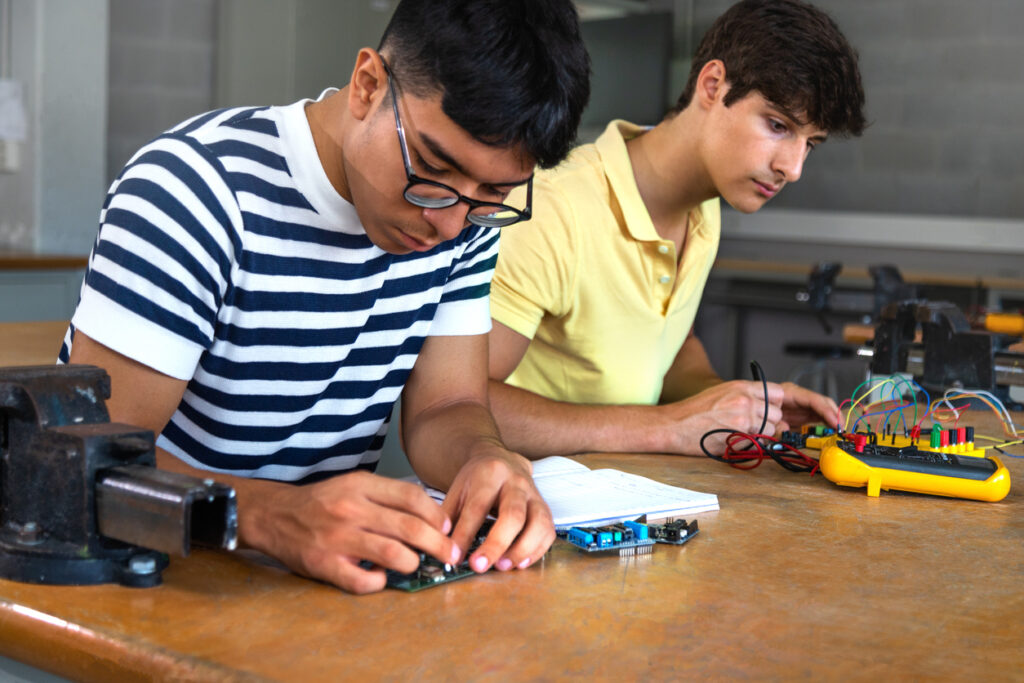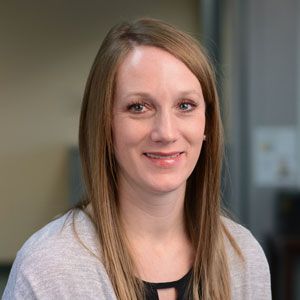The K-12 education landscape is evolving, offering more options for students and their families seeking alternatives to the traditional model. Many desire flexible learning environments that better align with their needs and interests. At the same time, educators and school leaders are rethinking how to make learning more engaging and centered around essential skills or competencies that students must master.
Two instructional models driving this shift are project-based learning (PBL)—where students gain knowledge by tackling real-world and personally meaningful projects—and competency-based education (CBE)—where students advance by demonstrating mastery of competencies or key skills rather than completing a set number of classroom hours.
At FlexTech High School, these two approaches come together in a flexible model that enables students to incorporate their interests as they progress at their own pace toward graduation. To explore how FlexTech blends PBL and CBE, Michigan Virtual Learning Research Institute (MVLRI) researchers spoke with Dr. Sarah Pazur, director of school leadership at CS Partners, who oversees the FlexTech High School network in Michigan. The transcript of our conversation was edited for clarity and brevity.
Can you tell us a little bit about FlexTech and why it was important for you to implement competency-based education?
FlexTech is a project-based, competency-based, blended-learning school offering face-to-face instruction Monday through Thursday with optional in-person student support offered on Fridays. All of our courses are accessible online through Google Classroom, allowing students to choose a learning model that works best for them—whether fully in-person, hybrid, or entirely online. Our advisory program, which is really focused on helping students find their purpose and make a plan for post-secondary that suits their passions and strengths, is the cornerstone of FlexTech. Beginning in the ninth grade, every student is paired with an advisor who follows them through their senior year and serves as an advocate for that student.
There are three FlexTech campuses, all located in Michigan: Brighton, Oakland, and Shepherd. Each campus is small by design, with around 175 students at both Brighton and Oakland and 80 at Shepherd. Our small size enables us to offer students many options, flexibility, and one-on-one instructional support. FlexTech was actually designed as a competency-based school from the start. It was born out of a desire to provide options for students to finish high school—whether they weren’t going to finish because they needed to work during the day, life circumstances made school difficult, or they left their previous school because they weren’t successful, we wanted to provide these students with an option. Our flexibility and personalized support are designed to serve a wide range of students, including those who may not have been successful in traditional models.
What challenges did FlexTech face in implementing competency-based education?
One of our biggest challenges has been finding an LMS (learning management system) and a gradebook that work well in a competency-based/project-based learning environment to account for all of the competency-based nuances (e.g., indicating the “rigor rating” of an assignment, coordinating with a student’s transcript). Many learning management systems are designed around the student’s schedule; however, we need one that focuses, instead, on the project. This allows us to more accurately track competencies and allow for flexibility in terms of mastery.
Another challenge has been tracking student progress. Because we’re competency-based, students can progress at their own pace, so we need detailed tracking systems to monitor which competencies each student has mastered and which still need work. Because of seat time (instructional time) requirements and expectations that students finish a course in a semester or in a year, we’ve had to create many of our own internal systems using spreadsheets and Google Docs, which allow teachers to make notes from semester to semester and year to year.
One area where we’ve experienced some pushback is around our grading scale. In our system, a 4.0 indicates a student can apply a skill in a new and novel way. However, the ceiling for an assignment that only requires mastery of a lower-level skill might be a 2.0. We’ve had to work hard to help parents understand that these numbers don’t directly translate to traditional letter grades.
Tell me a little bit about what competency-based education looks like in practice at FlexTech.
At FlexTech, competencies are primarily subject-based. While some competencies are multidisciplinary, most are tied to specific courses to ensure students meet credit requirements. To develop our competencies, we worked with curriculum designers and a consultant to create a crosswalk that aligns our competencies with state standards (e.g., MMC, NextGen, CCSS). This alignment process is crucial because it ensures that our competencies truly reflect the big ideas we want students to take away from each course. We continue to diligently revisit and revise these competencies to ensure they are still reflective of the right big ideas and standards.
PBL and CBE complement each other at FlexTech. Most courses are designed to be project-based; however, some are more authentically project-based than others, as we do offer some off-shoot traditional courses for students who need them (e.g., a basic math class). Typically, students either a) start a project based on a personal interest or current event, and then, with help, competencies are wrapped into the project; or b) teachers create the “frame,” outlining specific competencies for the project, and then students create the “focus” based on their interests. Projects run for 3-10 weeks and typically focus on 1-3 specific competencies. Milestones, formative feedback, and self-reflection are key components of every project. Our project-based approach helps avoid treating CBE as a checklist, keeping the focus on authentic learning experiences. While there is a general class pace, FlexTech offers flexibility through asynchronous learning for students who move faster or slower. Daily project support time and one-on-one appointments on Fridays provide additional individualized assistance to ensure students stay on track.
Grades at FlexTech focus purely on competency mastery, unlike traditional systems where behavior or extra credit might influence grades. Teachers provide ongoing formative feedback to help students gauge their progress. Each campus functions a little differently when it comes to its transcript. When I was the principal at the Oakland campus, we used a conversion scale because parents wanted a more traditional transcript. However, the Brighton and Shepherd campuses offer a fully competency-based transcript, which is accompanied by a one-page explanatory document for universities (and parents).
How do you measure success with regard to competency-based education?
We measure success in multiple ways. Because we’re project-based, students have the flexibility to demonstrate mastery of academic competencies in creative ways, which isn’t restricted by a rigid curriculum. Our smaller size allows us to track student progress very closely. Beyond academic competencies, we focus on students’ personal growth through the competencies outlined in our Portrait of a Graduate (e.g., passionate, problem-solver, growth mindset). Our Senior Chronicle serves as a culminating portfolio where students reflect on how they’ve grown throughout their time with us, including their ability to meet our Portrait of a Graduate competencies.
We also measure success by hearing stories of FlexTech students who are relieved of the traditional school “pressures” (e.g., lack of flexibility, social anxiety, inability to catch up) and are now finding their way. A fundamental part of FlexTech is taking students who are not doing well and helping them, whether that means helping them for five or maybe even six years. However, maintaining our identity and inclusivity within an education system with a strict four-year finish policy is a challenge.
What advice would you give to other school leaders interested in implementing competency-based education?
Start by staying true to your values and beliefs about teaching and learning. Implementing CBE is not just about helping students finish faster—it’s about embracing a philosophy that requires a complete system-wide shift. This means rethinking everything from your instructional framework to your scheduling, course offerings, and even your LMS. Developing a shared vision is crucial, and so is being prepared to make some concessions along the way.
It’s also essential to get everyone on board from the beginning, especially with the “why” behind CBE. We have a very personalized intake process, where we interview every family and explain how FlexTech functions. We also offer sessions during curriculum nights to educate parents and students about competency-based education and what it means for their learning journey.
Lastly, consider piloting the program on a small scale first to see how it fits within your school or district before going full-scale.
Final thoughts
FlexTech’s project-based and competency-based model is designed to give students more autonomy in how they meet academic standards and develop essential skills. While this approach provides opportunities for personalized support, it also presents challenges, such as navigating external expectations for a four-year graduation timeline and finding internal systems that can effectively track student progress in a non-traditional format. FlexTech continues to adapt its model in response to these challenges while maintaining a focus on individualized student growth.

